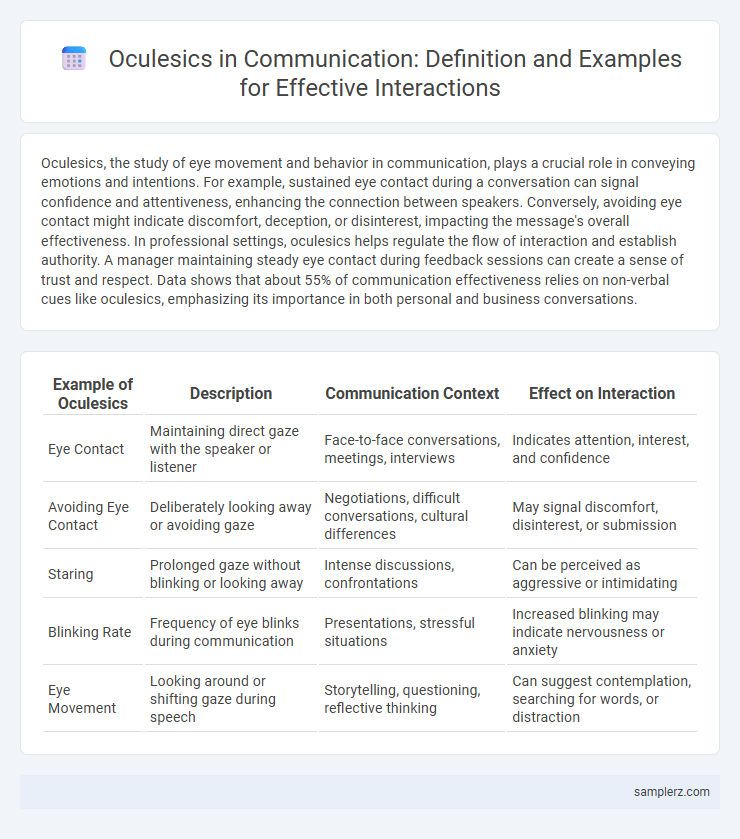Oculesics, the study of eye movement and behavior in communication, plays a crucial role in conveying emotions and intentions. For example, sustained eye contact during a conversation can signal confidence and attentiveness, enhancing the connection between speakers. Conversely, avoiding eye contact might indicate discomfort, deception, or disinterest, impacting the message's overall effectiveness. In professional settings, oculesics helps regulate the flow of interaction and establish authority. A manager maintaining steady eye contact during feedback sessions can create a sense of trust and respect. Data shows that about 55% of communication effectiveness relies on non-verbal cues like oculesics, emphasizing its importance in both personal and business conversations.
Table of Comparison
| Example of Oculesics | Description | Communication Context | Effect on Interaction |
|---|---|---|---|
| Eye Contact | Maintaining direct gaze with the speaker or listener | Face-to-face conversations, meetings, interviews | Indicates attention, interest, and confidence |
| Avoiding Eye Contact | Deliberately looking away or avoiding gaze | Negotiations, difficult conversations, cultural differences | May signal discomfort, disinterest, or submission |
| Staring | Prolonged gaze without blinking or looking away | Intense discussions, confrontations | Can be perceived as aggressive or intimidating |
| Blinking Rate | Frequency of eye blinks during communication | Presentations, stressful situations | Increased blinking may indicate nervousness or anxiety |
| Eye Movement | Looking around or shifting gaze during speech | Storytelling, questioning, reflective thinking | Can suggest contemplation, searching for words, or distraction |
Understanding Oculesics: The Role of Eye Behavior
Oculesics, the study of eye behavior in communication, reveals how eye contact, gaze direction, and blinking patterns convey emotions and intentions. Prolonged eye contact typically signals confidence and interest, while avoiding gaze may indicate discomfort or deceit. Understanding these subtle eye movements enhances interpersonal communication by providing nonverbal cues that complement spoken words.
Eye Contact as a Powerful Communication Tool
Eye contact serves as a crucial element in oculesics, conveying confidence, attentiveness, and emotional connection during communication. Studies reveal that maintaining appropriate eye contact can increase trust and engagement by up to 60%, enhancing message retention and interpersonal rapport. Effective use of eye contact regulates conversations, signals interest, and helps decode unspoken feelings, making it a powerful nonverbal communication tool.
Avoiding Eye Contact: Cultural and Psychological Meanings
Avoiding eye contact in communication often signals discomfort, submission, or disrespect depending on cultural norms and psychological states. In many East Asian cultures, avoiding direct gaze shows politeness and deference, contrasting with Western preferences for sustained eye contact as a sign of confidence and honesty. Psychologically, individuals may avoid eye contact due to anxiety, shyness, or a desire to conceal emotions, influencing interpersonal interactions and message interpretation.
The Impact of Gaze Duration in Conversations
Gaze duration significantly influences communication by regulating turn-taking and signaling attentiveness in conversations. Prolonged eye contact often conveys interest and confidence, while brief or averted gazes may indicate discomfort or disinterest. Research in oculesics reveals that optimal gaze duration varies across cultures, affecting interpersonal rapport and message interpretation during interactions.
Blinking Rate: Revealing Emotions and Intentions
Blinking rate in oculesics serves as a crucial indicator of a person's emotional state and intentions during communication. An increased blinking rate often signals stress, anxiety, or deception, while a reduced rate can suggest focus, interest, or discomfort. Understanding these subtle nonverbal cues enhances the accuracy of interpreting messages and strengthens interpersonal connections.
Pupil Dilation and Its Communicative Significance
Pupil dilation serves as a powerful nonverbal cue in communication, signaling emotions such as interest, attraction, or arousal. Studies show that dilated pupils can enhance interpersonal connection by indicating openness and attentiveness during interactions. This involuntary response often conveys sincerity and engagement, playing a crucial role in social bonding and trust-building.
Staring vs. Glancing: Interpreting Oculesic Signals
Staring in communication often conveys dominance, aggression, or intense focus, signaling a strong emotional state or intent to assert control. Glancing, by contrast, typically indicates casual interest, hesitation, or social politeness, serving as a subtle, nonverbal cue to gauge others' reactions without confrontation. Understanding these oculesic signals enhances interpersonal communication by decoding hidden emotional messages conveyed through eye behavior.
Role of Eye Movements in Nonverbal Communication
Eye movements play a crucial role in nonverbal communication by conveying emotions, intentions, and attention without spoken words. For instance, sustained eye contact can indicate confidence and interest, while rapid blinking or avoiding eye contact may signal discomfort or deceit. Understanding oculesics enhances the interpretation of social cues and improves interpersonal communication effectiveness.
Cross-Cultural Differences in Oculesics
Cross-cultural differences in oculesics significantly impact communication, as eye contact norms vary widely between societies. For instance, in Western cultures like the United States, sustained eye contact signifies confidence and attentiveness, whereas in East Asian cultures such as Japan, prolonged eye contact may be perceived as disrespectful or confrontational. Understanding these variations is crucial for effective intercultural communication, reducing misunderstandings caused by differing interpretations of gaze and eye behavior.
Practical Examples of Oculesics in Everyday Interactions
Oculesics, the study of eye movement and eye behavior in communication, plays a crucial role in everyday interactions such as maintaining eye contact during conversations to convey attentiveness and confidence. In negotiation scenarios, participants often use direct gaze to establish trust and assert dominance, while avoiding eye contact can signal discomfort or dishonesty. Social and cultural contexts also shape oculesic cues, as frequent eye contact is valued in Western cultures but may be perceived as intrusive in some Asian societies.

example of oculesics in communication Infographic
 samplerz.com
samplerz.com